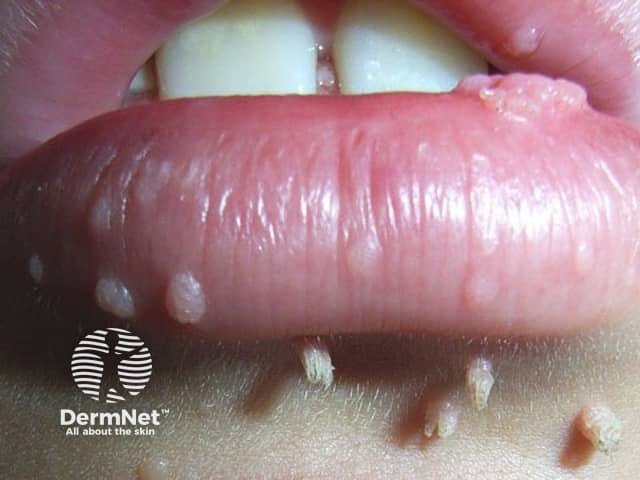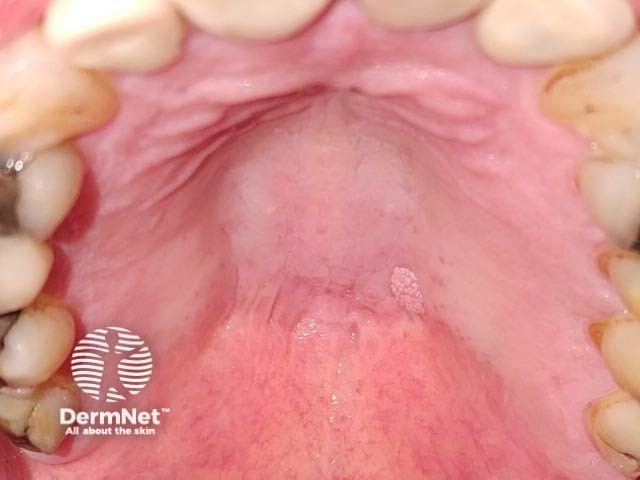Main menu
Common skin conditions

NEWS
Join DermNet PRO
Read more
Quick links
Squamous cell papilloma — extra information
Introduction
Squamous cell papilloma of the mouth and throat
Conjunctival papilloma
What is squamous cell papilloma?
Squamous cell papilloma may be defined as a small benign (non-cancerous) growth that begins in squamous cells (thin, flat cells) that are found in the tissue that forms the surface of the skin (epidermis), the passages of the respiratory and digestive tract and in the lining of hollow organs of the body.
Squamous cell papilloma is caused by infection with the human papillomavirus (HPV). When the papillomas are found on the skin they are more commonly referred to as warts or verrucas. And papillomas occurring on the genital tract are known as genital warts. Squamous cell papillomas may also occur on many other parts of the body. Squamous cell papilloma has been investigated as a disease entity on their own in the mouth and throat, oesophagus (digestive tract), respiratory tract and conjunctiva (the membrane that covers the eye).
Squamous cell papilloma of the mouth and throat
This may occur at any time throughout life but is usually diagnosed in people between 30-50 years old. The lesion may affect any part of the oral surface but is usually found on the tongue, inside surface of the cheeks, and lips.
Clinical features of squamous cell papilloma
A single lesion is most common and appears as a soft, pedunculated mass (supported on a stem or stalk) with numerous finger-like projections. The projections may be long and pointy or short and rounded if keratin (skin-forming protein) has built-up around the lesion. Less keratinised lesions are pink or red in colour and resemble a raspberry, whilst heavily keratinised lesions are white and look like the head of a cauliflower.

Viral warts

Oral squamous cell papilloma
Causes of squamous cell papilloma
The HPV subtypes most often found in oral squamous cell papilloma are HPV-6 and HPV-11. These subtypes are not associated with malignancy or precancer.
Management of squamous cell papilloma
Oral papillomas are painless and may be left untreated. They appear not to change in size, spread to other parts of the oral cavity, or turn into malignant tumours. If treatment is indicated then conservative surgical excision that removes the head and the base of the lesion may be performed. Recurrence is unlikely.
Papillomas found on the nasal or throat regions although sharing the same clinical features and histology as oral papillomas, differ in that usually more than one lesion is present, they proliferate continuously over time and often recur. In some cases, papillomas in the throat region may proliferate so much that they cause life-threatening asphyxiation (prevent breathing).
Conjunctival papilloma
One form of conjunctival papilloma is squamous cell papilloma. This is also known as infectious conjunctival papilloma because it is caused by infection with HPV types 6 and 11. They commonly occur in children and young adults before the age of 20. In some cases, the infection may occur at birth where an infected mother has passed on the virus. Patients with a history of warts on the skin may be at greater risk of getting conjunctival papilloma.
The papilloma is usually painless and does not cause any visual problems. Often no treatment is required and the lesion may regress spontaneously over time. As with other papillomas caused by HPV-6 and 11, the potential for malignant transformation is low. If treatment is required options available include cryotherapy and surgical excision with medical treatment.
On DermNet
Other websites
- Papilloma, Conjunctival from Medscape Reference
- Squamous Papilloma Maxillofacial Center for Education and Research
